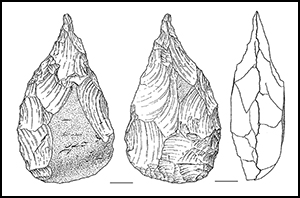Crossref Citations
This article has been cited by the following publications. This list is generated based on data provided by
Crossref.
Bae, Christopher J.
2017.
Late Pleistocene Human Evolution in Eastern Asia.
Current Anthropology,
Vol. 58,
Issue. S17,
p.
S514.
Nakazawa, Yuichi
2017.
On the Pleistocene Population History in the Japanese Archipelago.
Current Anthropology,
Vol. 58,
Issue. S17,
p.
S539.
Buzhilova, Alexandra
Derevianko, Anatoly
and
Shunkov, Michael
2017.
The Northern Dispersal Route.
Current Anthropology,
Vol. 58,
Issue. S17,
p.
S491.
Li, Feng
Kuhn, Steven L.
Chen, Fuyou
Wang, Yinghua
Southon, John
Peng, Fei
Shan, Mingchao
Wang, Chunxue
Ge, Junyi
Wang, Xiaomin
Yun, Tala
and
Gao, Xing
2018.
The easternmost Middle Paleolithic (Mousterian) from Jinsitai Cave, North China.
Journal of Human Evolution,
Vol. 114,
Issue. ,
p.
76.
Doyon, Luc
Li, Zhanyang
Li, Hao
d’Errico, Francesco
and
Petraglia, Michael D.
2018.
Discovery of circa 115,000-year-old bone retouchers at Lingjing, Henan, China.
PLOS ONE,
Vol. 13,
Issue. 3,
p.
e0194318.
d’Errico, Francesco
Doyon, Luc
Zhang, Shuangquan
Baumann, Malvina
Lázničková-Galetová, Martina
Gao, Xing
Chen, Fuyou
and
Zhang, Yue
2018.
The origin and evolution of sewing technologies in Eurasia and North America.
Journal of Human Evolution,
Vol. 125,
Issue. ,
p.
71.
Doyon, Luc
Li, Hao
Li, ZhanYang
Wang, Hua
and
Zhao, QingPo
2019.
Further Evidence of Organic Soft Hammer Percussion and Pressure Retouch from Lingjing (Xuchang, Henan, China).
Lithic Technology,
Vol. 44,
Issue. 2,
p.
100.
Hu, Yue
Marwick, Ben
Zhang, Jia-Fu
Rui, Xue
Hou, Ya-Mei
Yue, Jian-Ping
Chen, Wen-Rong
Huang, Wei-Wen
and
Li, Bo
2019.
Late Middle Pleistocene Levallois stone-tool technology in southwest China.
Nature,
Vol. 565,
Issue. 7737,
p.
82.
Li, Hao
Li, Zhan-yang
Gao, Xing
Kuman, Kathleen
and
Sumner, Alexandra
2019.
Technological behavior of the early Late Pleistocene archaic humans at Lingjing (Xuchang, China).
Archaeological and Anthropological Sciences,
Vol. 11,
Issue. 7,
p.
3477.
Zhou, Yuduan
Ji, Xueping
Li, Yinghua
Forestier, Hubert
Jablonski, Nina G.
Ding, Shan
Zhao, Jiamei
Chen, Peng
Wang, Liwei
Liang, Tingting
and
He, Chengpo
2020.
Tangzigou open-air site: A unique lithic assemblage during the Early Holocene in Yunnan Province, Southwest China.
Quaternary International,
Vol. 563,
Issue. ,
p.
105.
Demeter, Fabrice
and
Bae, Christopher J.
2020.
Dispersal Barriers into Southeast Asia during the Late Pleistocene.
Quaternary International,
Vol. 563,
Issue. ,
p.
1.
Zhao, Qingpo
Ma, Huanhuan
and
Bae, Christopher J.
2020.
New discoveries from the early Late Pleistocene Lingjing site (Xuchang).
Quaternary International,
Vol. 563,
Issue. ,
p.
87.
Wang, Wei
Bae, Christopher
and
Xu, Xin
2020.
Chinese Prehistoric Eyed Bone Needles: A Review and Assessment.
Journal of World Prehistory,
Vol. 33,
Issue. 3,
p.
385.
Shin, Seungwon
Park, Yong‐Hee
Lim, Jaesoo
Cheong, Daekyo
Choi, Seung‐Yup
Choi, Jeong‐Heon
Jun, Chang‐Pyo
Lim, Hyoun Soo
and
Lee, Jin‐Young
2022.
Possible linkage between Paleolithic site occurrence and past climate change in the central Korean Peninsula.
Geoarchaeology,
Vol. 37,
Issue. 6,
p.
887.
Ikawa-Smith, Fumiko
2022.
Maritime Prehistory of Northeast Asia.
Vol. 6,
Issue. ,
p.
51.
Kim, Jangsuk
and
Seong, Chuntaek
2022.
Final Pleistocene and early Holocene population dynamics and the emergence of pottery on the Korean Peninsula.
Quaternary International,
Vol. 608-609,
Issue. ,
p.
203.
Kim, Jangsuk
and
Seong, Chuntaek
2022.
Maritime Prehistory of Northeast Asia.
Vol. 6,
Issue. ,
p.
29.
Morisaki, Kazuki
Shiba, Kojiro
and
Choi, Donghyuk
2022.
Examining frequency and directionality of Palaeolithic sea-crossing over the Korea/Tsushima Strait: a synthesis.
World Archaeology,
Vol. 54,
Issue. 2,
p.
162.
Park, Gayoung
and
Marwick, Ben
2022.
How did the introduction of stemmed points affect mobility and site occupation during the late Pleistocene in Korea?.
Quaternary Science Reviews,
Vol. 277,
Issue. ,
p.
107312.
Park, Gayoung
Lombard, Marlize
Chong, Donghee
and
Marwick, Ben
2023.
Variation in Use of East Asian Late Paleolithic Weapons: a Study of Tip Cross-sectional Area of Stemmed Points from Korea.
Journal of Paleolithic Archaeology,
Vol. 6,
Issue. 1,
